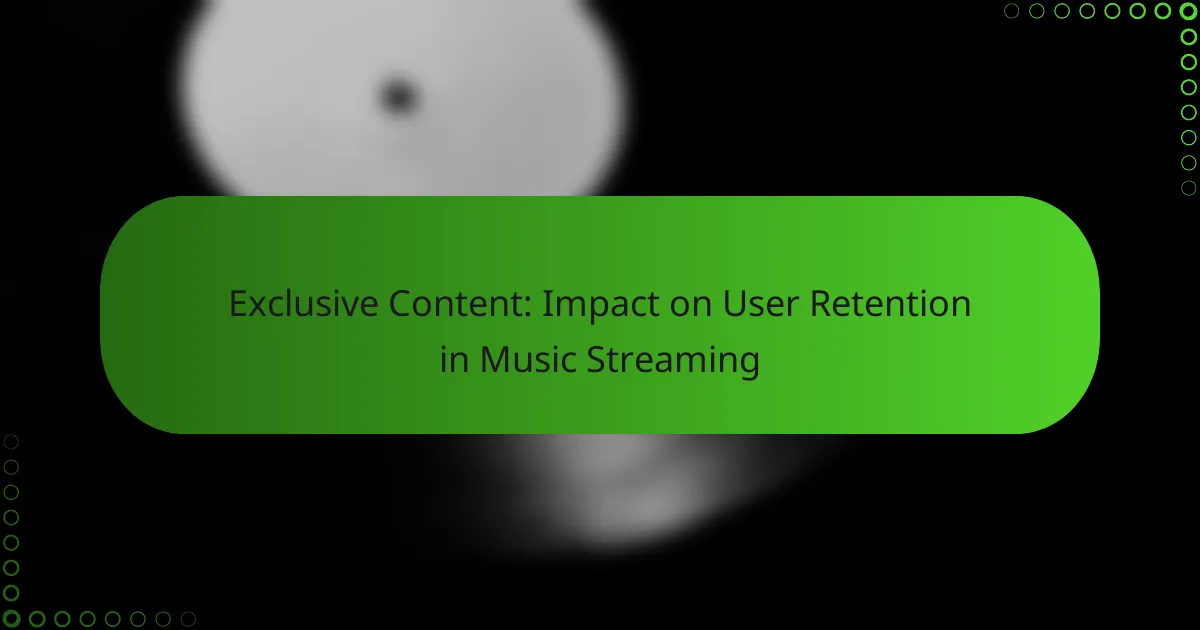The music libraries of major streaming services such as Spotify, Apple Music, Amazon Music, YouTube Music, and Tidal vary significantly in size, impacting user experience and content availability. While each platform boasts millions of tracks, the exact number can influence listeners’ choices based on their musical preferences. Factors like licensing agreements, exclusive content, and regional restrictions play a crucial role in determining the size of these libraries.

Which streaming services offer the largest music libraries?
The largest music libraries are found on Spotify, Apple Music, Amazon Music, YouTube Music, and Tidal. Each service offers a vast selection of tracks, but the total number can vary significantly, affecting user experience and choice.
Spotify music library size
Spotify boasts a music library that exceeds 70 million tracks, making it one of the largest platforms available. Its extensive catalog includes a wide range of genres, playlists, and user-generated content, appealing to diverse musical tastes.
Additionally, Spotify frequently updates its library with new releases and exclusive content, ensuring that users have access to the latest hits and emerging artists. This dynamic environment enhances user engagement and discovery.
Apple Music music library size
Apple Music offers a library of over 100 million songs, positioning it as a strong competitor in the streaming market. The platform emphasizes high-quality audio and curated playlists, which can enhance the listening experience.
Apple Music also integrates seamlessly with the Apple ecosystem, allowing users to access their music across devices. This integration can be a significant advantage for users who are already invested in Apple’s products.
Amazon Music music library size
Amazon Music provides access to more than 100 million songs, similar to Apple Music. The service offers various tiers, including a free version with ads and a premium subscription that unlocks additional features and higher quality audio.
For Amazon Prime members, the service includes a selection of songs at no extra cost, making it an attractive option for those already subscribed to Prime. However, the full library is only available with the paid subscription.
YouTube Music music library size
YouTube Music features a library of over 80 million songs, including official tracks, remixes, and user-uploaded content. This variety allows users to explore a wider range of music, including rare and independent artists.
The platform’s integration with YouTube enhances its appeal, as users can easily switch between audio and video formats. However, the experience may vary based on regional licensing agreements, which can limit access to certain tracks.
Tidal music library size
Tidal offers a music library of around 100 million songs, focusing on high-fidelity audio and exclusive content from popular artists. This emphasis on sound quality attracts audiophiles and those seeking a premium listening experience.
Tidal also features unique content such as music videos and artist interviews, which can enrich the user experience. However, its higher subscription cost may be a consideration for potential users compared to other services.

How do music library sizes compare across platforms?
Music library sizes vary significantly across streaming platforms, impacting user experience and content availability. Major services like Spotify, Apple Music, Amazon Music, and Tidal each offer millions of tracks, but the exact number can influence your choice depending on your music preferences.
Spotify vs Apple Music comparison
Spotify boasts a library of over 70 million tracks, making it one of the largest music streaming services available. In comparison, Apple Music offers a similar range, with around 100 million songs, providing a slight edge in terms of content variety.
When choosing between these two, consider the user interface and features. Spotify is known for its playlists and discovery algorithms, while Apple Music integrates seamlessly with the Apple ecosystem, appealing to users with Apple devices.
Amazon Music vs YouTube Music comparison
Amazon Music has a library of over 100 million songs, which is comparable to Apple Music. YouTube Music, on the other hand, offers a unique advantage by including official music videos along with its library of around 80 million tracks, appealing to users who enjoy visual content.
For users who prioritize music videos and live performances, YouTube Music may be the better choice. However, if you are an Amazon Prime member, you may find Amazon Music’s bundled services more cost-effective.
Tidal vs Spotify comparison
Tidal offers around 80 million tracks, which is competitive with Spotify’s library. However, Tidal distinguishes itself with its focus on high-fidelity audio quality, appealing to audiophiles who prioritize sound over sheer volume of content.
When deciding between Tidal and Spotify, consider your listening habits. If you value audio quality and exclusive content from artists, Tidal may be worth the investment. Conversely, if you prefer a broader selection of playlists and music discovery features, Spotify might be the better option.

What factors influence music library size?
Several key factors influence the size of music libraries across streaming services, including licensing agreements, exclusive content, and regional restrictions. Each service negotiates different deals with record labels and artists, which directly affects the number of available tracks.
Licensing agreements impact
Licensing agreements are crucial in determining the music library size for streaming platforms. These agreements dictate which songs can be offered and under what terms. For instance, services like Spotify and Apple Music may have different arrangements with major record labels, resulting in varying track availability.
Platforms often negotiate exclusive rights to certain artists or albums, which can further differentiate their libraries. This means that a song available on one service may not be accessible on another due to these contractual obligations.
Exclusive content availability
Exclusive content availability plays a significant role in the attractiveness of a music library. Some streaming services secure exclusive releases from popular artists, which can draw subscribers looking for specific tracks or albums. For example, Tidal has been known for exclusive releases from high-profile artists like Jay-Z and Beyoncé.
This exclusivity can enhance a platform’s appeal, but it may also limit the overall size of its library. Users should consider whether they prioritize exclusive tracks or a broader selection of music when choosing a service.
Regional restrictions
Regional restrictions can significantly impact the music library size on streaming services. Licensing laws vary by country, which means that some tracks may be available in one region but not in another. For instance, a song might be accessible in the United States but restricted in Europe due to different licensing agreements.
Users should be aware of these regional limitations, especially if they travel frequently or reside in different countries. Some services offer features like VPN compatibility, allowing users to access a broader range of content, but this can sometimes violate terms of service.

What are the implications of music library size for users?
The size of a music library on streaming services significantly impacts user experience, content variety, and subscription costs. A larger library typically offers more choices, but it can also affect how users discover and engage with music.
User experience considerations
A larger music library can enhance user experience by providing a broader selection of songs and genres. However, it may also lead to decision fatigue, where users feel overwhelmed by too many options. Services with curated playlists or personalized recommendations can help mitigate this issue.
Additionally, the interface design plays a crucial role. Users may prefer platforms that allow easy navigation and quick access to their favorite tracks, regardless of library size. Features like search filters and smart playlists can improve usability.
Content diversity effects
The size of a music library directly influences content diversity, which can enrich the listening experience. A vast library often includes a mix of mainstream hits and niche genres, appealing to a wider audience. This diversity can foster music discovery and cultural exploration.
However, not all large libraries are equal. Some may prioritize popular music, while others focus on independent artists or international sounds. Users should consider their preferences when choosing a service, as this can affect their overall satisfaction.
Subscription pricing strategies
Music library size can impact subscription pricing strategies across streaming services. Generally, platforms with extensive libraries may charge higher fees, reflecting the costs of licensing a broader range of content. Users should weigh the value of access to a larger library against their budget.
Some services offer tiered pricing, where users can choose plans based on library access or additional features like offline listening. It’s essential to evaluate these options to find a plan that aligns with individual listening habits and financial considerations.

How to choose a streaming service based on music library size?
Choosing a streaming service based on music library size involves evaluating the number of tracks available and the diversity of genres offered. A larger library typically provides more options, but consider the specific artists and genres you prefer to ensure the service meets your needs.
Criteria for selection
When selecting a streaming service, consider factors such as the total number of songs, the variety of genres, and the presence of exclusive content. Look for services that offer a mix of popular hits and niche genres to match your listening preferences.
Additionally, assess the quality of the audio streaming and whether the service supports offline listening. Some platforms may have extensive libraries but lack high-quality audio options, which can affect your overall experience.
Comparative analysis framework
To effectively compare music library sizes across streaming services, create a simple table listing each service alongside key metrics such as total song count, genre variety, and exclusive content. This visual representation can help you quickly identify which service aligns best with your music tastes.
Consider user reviews and expert ratings as part of your analysis. These insights can provide context on how well each service curates its library and whether it frequently updates its offerings with new music.

What are the emerging trends in music libraries?
Emerging trends in music libraries reflect a shift towards greater diversity and accessibility, particularly with the rise of independent artists. Streaming services are increasingly featuring a wider array of genres and styles, allowing listeners to discover new music beyond mainstream offerings.
Growth of independent artists
The growth of independent artists is significantly shaping music libraries across streaming platforms. With the advent of digital distribution, many artists can now release their music without traditional label support, leading to a surge in unique sounds and niche genres.
This trend has resulted in streaming services expanding their catalogs to include a broader selection of independent music. For example, platforms like Bandcamp and SoundCloud have become popular for discovering emerging talent, while major services like Spotify and Apple Music are curating playlists that highlight indie artists.
Listeners can expect to find a richer variety of music, as independent artists often experiment with different styles and themes. This diversity not only enhances the listening experience but also promotes a more inclusive music culture.










